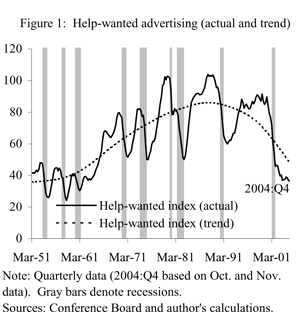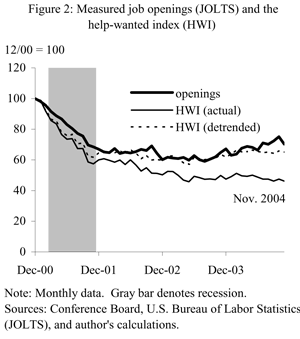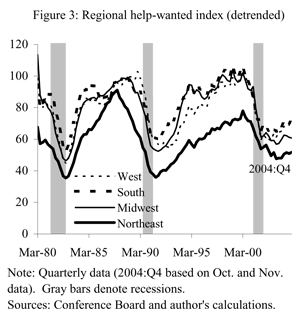The job vacancy rate, which represents employers’ unmet labor demand, is an important indicator of the short-term outlook for hiring and job creation. Because there is no continuous aggregate vacancy series in the United States, analysts and observers interested in labor demand and hiring activity have relied on the Conference Board’s “Help-Wanted Advertising Index” to measure changes in job vacancies over time.
- Adjusting the help-wanted advertising index
- Job vacancies
- National and regional labor demand
- Conclusion
- References
The job vacancy rate, which represents employers’ unmet labor demand, is an important indicator of the short-term outlook for hiring and job creation. Because there is no continuous aggregate vacancy series in the United States, analysts and observers interested in labor demand and hiring activity have relied on the Conference Board’s “Help-Wanted Advertising Index” to measure changes in job vacancies over time. This index is based on counts of help-wanted advertisements in major newspapers nationwide. The information contained in these series has proved useful not only to economic forecasters but also to researchers studying aggregate labor market conditions and performance. For example, using the help-wanted index, Abraham (1987) concluded that the effectiveness of the job-matching process between employers and employees in the United States declined between the 1960s and early 1980s, while Bleakley and Fuhrer (1997) argued that the effectiveness of job matching rose in the late 1980s and early 1990s.
Due to its reliance on newspaper advertising, however, the help-wanted index is an indirect measure of job vacancies. The level of job advertisements appearing in newspapers may change for reasons that are unrelated to overall labor demand. For example, equal employment opportunity laws raised the level of newspaper job advertising in the 1960s and 1970s, while internet job advertising has served as an increasingly effective substitute for newspaper advertising in recent years. In this Economic Letter, I discuss how the help-wanted index can be adjusted for such factors, yielding a more reliable measure of short-term and long-term movements in job vacancies. I compare the adjusted help-wanted series to a direct measure of job openings recently made available by the U.S. Bureau of Labor Statistics (BLS), through their monthly Job Openings and Labor Force Turnover Survey (JOLTS). After adjustment, the help-wanted series confirms the JOLTS series’ indication of a recent uptick in labor demand for the nation as a whole and several broad regions, although the increase is not yet sufficiently sustained or pronounced to indicate that a broad employment recovery has fully taken hold.
Adjusting the help-wanted advertising index
The Conference Board, a not-for-profit business research organization headquartered in New York City, produces the help-wanted index (the data are described in detail in Abraham 1987). Briefly, the help-wanted index is based on a monthly count of help-wanted advertisements appearing in the classified section of a major newspaper in each of 51 cities nationwide. Using nonfarm payroll employment levels as weights, the city data are aggregated up to provide help-wanted index series for nine major regions and the United States as a whole (with the series all normalized to equal 100 in 1987). These series have been available on a monthly basis since 1951.
It is well known, however, that the level of newspaper help-wanted advertising responds not just to labor market conditions narrowly defined but also to extraneous factors that are not directly related to overall labor demand. These factors include the occupational composition of employment (white-collar jobs are more likely to be advertised than blue-collar jobs), increased job advertising linked to equal employment opportunity pressures, and consolidation in newspaper markets. Abraham (1987) estimated that these factors generated an upward drift in the help-wanted index averaging nearly 1% per year between 1960 and 1985.
Subsequent work using the help-wanted index has relied on Abraham’s approach to enhance the accuracy of the help-wanted index as a measure of job vacancies, extending her adjustments forward in a straightforward fashion (for example, Bleakley and Fuhrer 1997). Recent factors, however, including growing reliance on alternative sources of job advertising such as the internet, may have produced a downward rather than upward drift in help-wanted advertising volume. Under these circumstances, a straightforward extension of Abraham’s adjustments may not accurately capture trends in the help-wanted index that are unrelated to overall labor demand.
 To address these issues, Shimer (2004) proposed and implemented a purely statistical approach to adjusting the help-wanted index. In particular, he used a data-smoothing technique known as the “Hodrick-Prescott (HP) filter.” This technique is commonly applied to economic data series to remove short-term fluctuations that are associated with the business cycle, thereby identifying long-term trends. Figure 1 displays the actual help-wanted series and its long-term trend as estimated by an HP filter. The actual series exhibits sharp cyclical swings centered on the shaded recessionary periods. However, an underlying long-term upward trend is evident through about 1990. After 1990, a pronounced downward trend was established and intensified, corresponding to a period when employers increasingly relied on the internet and sources other than newspapers to post job openings. These trends are reflected in the peaks in the data series, which were rising through the late 1980s and fell subsequently.
To address these issues, Shimer (2004) proposed and implemented a purely statistical approach to adjusting the help-wanted index. In particular, he used a data-smoothing technique known as the “Hodrick-Prescott (HP) filter.” This technique is commonly applied to economic data series to remove short-term fluctuations that are associated with the business cycle, thereby identifying long-term trends. Figure 1 displays the actual help-wanted series and its long-term trend as estimated by an HP filter. The actual series exhibits sharp cyclical swings centered on the shaded recessionary periods. However, an underlying long-term upward trend is evident through about 1990. After 1990, a pronounced downward trend was established and intensified, corresponding to a period when employers increasingly relied on the internet and sources other than newspapers to post job openings. These trends are reflected in the peaks in the data series, which were rising through the late 1980s and fell subsequently.
The changing direction and degree of trending in the help-wanted series indicate the importance of adjusting it for the long-term influences noted above. However, it is difficult to know whether these adjustments are informative unless they are anchored to an independent, reliable measure of job vacancies. The JOLTS data from the U.S. BLS can be used for this purpose. The JOLTS is administered to a representative sample of about 16,000 establishments nationwide, and it provides data on job openings as well as new hires and separations (voluntary and involuntary). The definition of a job opening (vacancy) is quite precise, reflecting that: (1) a specific position exists, (2) work could start within 30 days, and (3) the employer is actively recruiting from outside the establishment that has the opening. All types of openings are surveyed, including part-time and temporary jobs. In addition to the national series, the data are available by region—the Northeast, Midwest, South, and West (JOLTS survey information is available online at http://www.bls.gov/jlt/home.htm; see also Clark and Hyson 2001). The JOLTS series only became available in December 2000, near the peak of the last expansion, which currently limits its use for business cycle analysis. However, its adjustment pattern since then provides useful information for assessing the reliability of the help-wanted index as a measure of job vacancies.
 As Figure 2 shows, when its long-term trend is removed, the help-wanted series corresponds well to the pattern in job openings measured directly from JOLTS (the figure displays monthly values of the JOLTS job opening series, the actual help-wanted index series, and the help-wanted index series detrended using an HP filter and adjusted so that its mean equals the mean of the actual series). Each series is normalized to a value of 100 in December 2000, so that the series’ patterns can be compared on the same basis over time. After declining sharply during the recession, the actual help-wanted series has been largely flat since late 2002. As expected, the downward trend in the help-wanted series causes it to lie well below the JOLTS job openings series, while the detrended help-wanted series lies quite close to the JOLTS series. Looking past their short-term fluctuations, the movements in the two series match fairly well, with both showing a slight upward trend since the middle of 2003.
As Figure 2 shows, when its long-term trend is removed, the help-wanted series corresponds well to the pattern in job openings measured directly from JOLTS (the figure displays monthly values of the JOLTS job opening series, the actual help-wanted index series, and the help-wanted index series detrended using an HP filter and adjusted so that its mean equals the mean of the actual series). Each series is normalized to a value of 100 in December 2000, so that the series’ patterns can be compared on the same basis over time. After declining sharply during the recession, the actual help-wanted series has been largely flat since late 2002. As expected, the downward trend in the help-wanted series causes it to lie well below the JOLTS job openings series, while the detrended help-wanted series lies quite close to the JOLTS series. Looking past their short-term fluctuations, the movements in the two series match fairly well, with both showing a slight upward trend since the middle of 2003.
Additional comparisons (not shown) reveal that the detrended help-wanted series also does a much better job of matching the JOLTS series than does the unadjusted help-wanted series for the four broad regions available in the JOLTS data, although the match is not as precise as it is at the national level. Overall, this evidence suggests that the detrended help-wanted index provides a reasonably accurate measure of changes in job vacancies, although a more reliable calibration must wait for the continuation of the JOLTS series across a longer time period that includes a complete business cycle.
National and regional labor demand
 In addition to its availability over a lengthy period, the help-wanted index possesses the advantage of being available for nine broad regions comprising the entire United States. For visual simplicity, Figure 3 displays the help-wanted series for the four broad regions available in the JOLTS, which represent combinations of the nine underlying subregions for which help-wanted data are available (nonfarm payroll employment was used as the weighting factor to combine values across regions). Each series is detrended in a manner similar to that used for the national series in Figure 2. The regional help-wanted series in general display a cyclical pattern that is similar to the nation’s, with each exhibiting sharp declines prior to the onset of recessions. Although the regional series generally move together, a notable exception is the decline in help-wanted advertising in the Northeast region beginning in early 1988, well ahead of the decline in other regions heading into the recession of 1990-1991.
In addition to its availability over a lengthy period, the help-wanted index possesses the advantage of being available for nine broad regions comprising the entire United States. For visual simplicity, Figure 3 displays the help-wanted series for the four broad regions available in the JOLTS, which represent combinations of the nine underlying subregions for which help-wanted data are available (nonfarm payroll employment was used as the weighting factor to combine values across regions). Each series is detrended in a manner similar to that used for the national series in Figure 2. The regional help-wanted series in general display a cyclical pattern that is similar to the nation’s, with each exhibiting sharp declines prior to the onset of recessions. Although the regional series generally move together, a notable exception is the decline in help-wanted advertising in the Northeast region beginning in early 1988, well ahead of the decline in other regions heading into the recession of 1990-1991.
Consistent with weak payroll employment growth since the end of the 2001 recession, help-wanted advertising has been largely flat in the Northeast and has shown only modest recovery in the other three regions (compared with the recovery in these series during periods following previous recessions). The aggregation into broad regions masks some differences across the nine underlying subregions. Most significantly, the recent gains in help-wanted advertising in the West have been confined to the Mountain states (Arizona, Colorado, and Utah), whereas the series has been flat for the Pacific region (primarily California). This pattern is consistent with solid payroll employment growth in the Mountain states and relatively weak growth in California over the past year.
The Conference Board’s help-wanted advertising index is a useful measure of job openings and the state of labor demand in the United States. Indeed, its availability over a long time period and at the level of disaggregated regions makes it the only feasible data source for assessing important aspects of the labor market operations, such as the effectiveness of the job-matching process. Depending on the intended application, the help-wanted series may be most useful when adjusted for underlying trends that are unrelated to labor market conditions; when this is done, the series is quite comparable to the series on directly measured job openings from the BLS’s relatively new JOLTS database. Once a sufficiently long time series has been established, the JOLTS series on hiring activity and job turnover will prove useful for detailed and diverse labor market analyses not currently possible with other data sources. For the time being, both data sources indicate only a limited pickup in employers’ desired hiring since the end of the 2001 recession, confirming the generally weak employment growth figures (compared with recoveries from past recessions) obtained from the BLS’s nonfarm payroll employment series.
Rob Valletta
Research Advisor
Abraham, Katharine G. 1987. “Help-Wanted Advertising, Job Vacancies, and Unemployment.” Brookings Papers on Economic Activity 1, pp. 207-248.
Bleakley, Hoyt, and Jeffrey C. Fuhrer. 1997. “Shifts in the Beveridge Curve, Job Matching, and Labor Market Dynamics.” New England Economic Review (September/October) pp. 3-19.
Clark, Kelly A., and Rosemary Hyson. 2001. “New Tools for Labor Market Analysis: JOLTS.” Monthly Labor Review 124(12) (December) pp. 32-37.
Shimer, Robert. 2004. “The Cyclical Behavior of Equilibrium Unemployment and Vacancies.” Mimeo, Department of Economics, University of Chicago, June 16 (forthcoming in American Economic Review).
Opinions expressed in FRBSF Economic Letter do not necessarily reflect the views of the management of the Federal Reserve Bank of San Francisco or of the Board of Governors of the Federal Reserve System. This publication is edited by Anita Todd and Karen Barnes. Permission to reprint portions of articles or whole articles must be obtained in writing. Please send editorial comments and requests for reprint permission to research.library@sf.frb.org